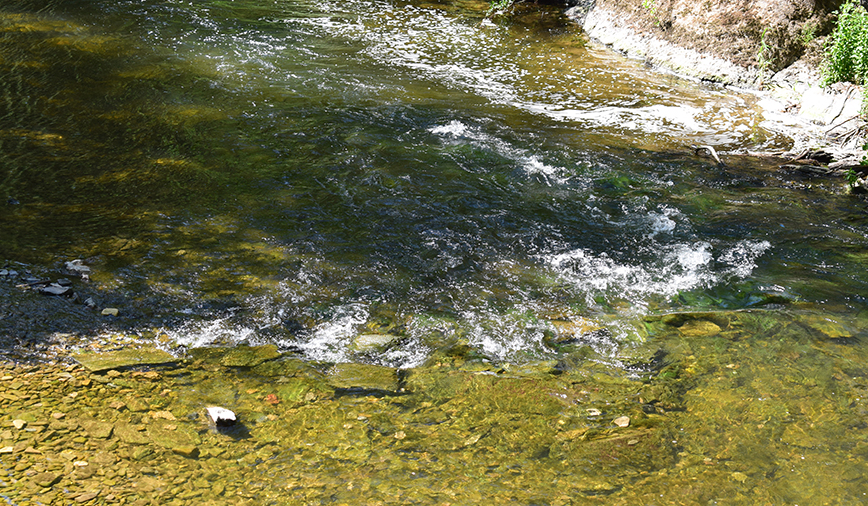Pam’s Perspective
From the…
Pam Otto is the Manager of Natural Programs and Interpretive Services for the St. Charles Park District
July 27, 2012
I suppose when most people think of rolling stones, the phrase is capitalized and preceded by a “The.” Images of big lips, a lolling tongue, Mick Jagger and Keith Richards come to mind, perhaps accompanied by a few lyrics or the opening notes of You Can’t Always Get What You Want.
But when naturalists, especially those who find themselves standing in a creek on a warm summer day, speak of rolling stones, the term takes on a different context. Entirely.
I know this.
No surprise there.
But I’ll bet you would be talking about lower case rolling stones too, if you were to find yourself in the same place, looking at the same amazing sights.
Stream beds are spawning grounds for any number of game and nongame fish species. Some may sound familiar, like smallmouth bass and other members of the sunfish family. Others are a little more obscure, like hornyhead chubs and the aptly named central stoneroller—a small fish with big, Jagger-like lips.
Whether you know these guys or not, their behavior is nonetheless fascinating.
Unlike the bird world, where homemaking duties frequently fall to the female, fish nest building is largely the responsibility of the males. While some rely on aquatic vegetation to provide suitable structure, and others simply fan away debris to make way for eggs deposited by visiting females, it’s the rockin’, rollin’, or, actually, rock-rollin’ species that really grab my attention. These guys use their mouths and snouts to roll rocks, ranging in size from small pebbles up to chunks of gravel, into alluring mounds, ridges or saucer-shaped depressions designed to grab the attention of passing females.
Adobe Systems
Last weekend, looking through the clear (and, this year, really shallow) water of Ferson Creek, my friend Jessi and I were able to pick out several fish nests as we walked the stream to prep for an upcoming freshwater mussels class.
Ferson Creek has a fair amount of silt in it these days, and the minuscule particles have settled and buried lots of the gravel that characterizes this once-fine creek’s bed. While the silt isn’t great for the overall health of the stream system, it does make it way easier to spot the creations of hardworking male fish.
Conical mounds and round wells dot the streambed. You can see them as you wade in the creek but, even better (at least for folks who might not keep their waders at the ready) you can spot many from the bank too.
Since fish breeding activity typically is triggered by spring’s warming, and the waters in our area have been warm for a loooong time now, most of these structures are no longer in use. But when they were, it would have been possible to observe some of the captivating behavior displayed when fish are breeding.
While you’d think that the male that does the nestbuilding would be the guy who gets the girl, so to speak, that’s not always the case. In some species, like certain members of the sunfish family, satellite and sneaker males add intrigue by freeloading off the efforts of nestbuilding males. The satellites and sneakers, masquerading as females or juvenile males, lurk around a nest and, when an actual female eventually arrives, swoop in and make an effort to hijack the whole reproductive proceeding.
Interestingly, for many of our local fish species, it’s mama who’s the rolling stone. Females stay only long enough to deposit some eggs; in many species, they then swim off to visit the nests of other expectant males. (Largemouth bass are a notable exception; research indicates that many members of this species are monogamous, at least for a season.)
In some species, papa leaves too, leaving the eggs and fry to fare for themselves. In certain others, however, males will stick around, protecting their progeny day and night from all manner of threats. With fish eggs and fry ranking high on the list of virtually every other predator in the stream, even a quick trip away for sustenance could result in the loss of the entire brood. What’s a poor father to do?
Why, eat a few of the kids of course. As much as we’d like to apply human values like commitment and devotion to the male’s conduct, in the end it’s survival that’s the name of the game. And after all, protein is protein.
It will be almost a year before another fish breeding cycle, and the stone-rolling behavior that accompanies it, appears again in our local streams. But right now, while water levels are low, is a great time to head out and view the structures of the season that has just passed. Look for unusually clean bits of gravel arranged in circular fashion, in diameters that range from a few inches to a foot or more across.
Rain, though, will make seeing these nests a lot more difficult. Increased flow in the streams will stir up silt and increase turbidity, turning some of our local creeks into surging courses of chocolate-brown soup while simultaneously returning life-giving water to the land.
It’s true, you can’t always get what want. But sometimes, you just might find, you get what you need.
Eclectic in her music choices but a nature nerd through and through, Pam Otto is the manager of nature programs and interpretive services for the St. Charles Park District. She can be reached at 630-513-4346 or potto@stcparks.org.

